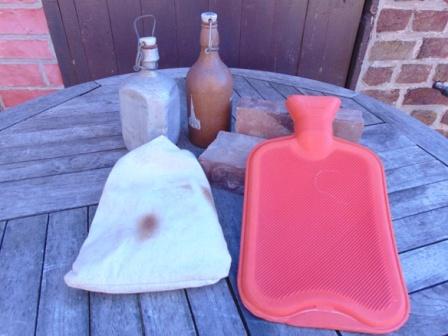Hot water bottle or hottie, and samovar
Previously (when there were no electric blankets and the animals still were talking) we took a rubber hot water bag to bed. Or rather: we covered it in advance. With a towel around it, so as not to burn our feet. That was a long blissfully warmth in cold winter nights. Who has yet seen the frost flowers that frost painted on the (single) glass of the bedroom windows?
 Before that there were jars of stone and zinc.
Before that there were jars of stone and zinc.
(There were also metal warming pans used with embers, that seems too hot and a fire hazard.)
If you have fear of wet feet in bed you can replace water in jar by cherry pits pillow. Put them in the oven, or in a heatproof bowl (with lid) on (a grid on) the stove.
If you collect pits for this, put them a time on an ants’nest. The ants will bite all the leftovers.
You can also warm up some large stones on the stove. Bricks are great. Before laying them in bed, wrap some (old) (hand) towels around them, and fix them with a few safety pins.
Cold feet to dive between the cold sheets? Just before going to bed iron the sheet on the mattress quite warm , that makes it twice as nice.
And if that is too cumbersome then bed socks and a nightcap (literally) can protect you from a cold bed and help keep your body heat.
It was also believed that a nightcap would prevent the spread of head lice.
But considering you lose most heat through your head, which is also is usually not under cover, it is a clever invention. Especially in a time when moonlight and snow felled trough the gaps of the Pottelberg tiles and the cold in an attic where it wasn’t warmer than just outside painted beautiful ice flowers on frost windows. They were also worn inside and outdoors. The pointed hat was for men. Women wore a rounder "sleep hat." In Volendamweare colored ones in the 19th century even worn by the Sunday suit.
A nightcap is also a (last) dram that one drink before going home or going to bed.
A samovar is a Russian or Turkish tea machine, consisting of a (copper) boiler with a tap, whit a (now electric- or) charcoal fire in. The name comes from the Russian and means ’self cooker’. You could say it's a table heater, you might as well other things prepare or keep warm. (Gourmet, fondue...)
(Charcoal was also used in the same way as a filling for heating (metal) bedpans and irons.)
To feel a bit warm in a cold room there is in Japan (but also in some other countries) the kotatsu. A table with a heater underneath. In the 14th century, fueled by charcoal. Nowadays electric. Across the table hangs a thick (like sleeping bag) garment to the ground. Evening is the whole family with the feet under the table. Nice and warm, with little usage.
